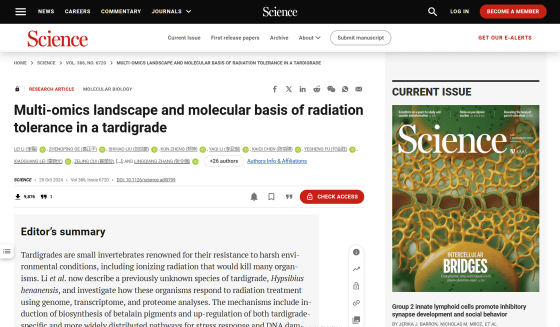The secret of tardigrades' incredible radiation resistance revealed by genetic research

by
Tardigrades are tiny animals with a body length of just 50μm to 1.7mm, and are known for their ability to withstand extremely high and low temperatures, vacuum conditions, high doses of radiation, etc. A new study investigating the genes expressed when tardigrades are exposed to radiation has revealed the secret of tardigrades' incredible radiation resistance.
Multi-omics landscape and molecular basis of radiation tolerance in a tardigrade | Science
https://www.science.org/doi/10.1126/science.adl0799

New Tardigrade Discovery Reveals Secrets of Radiation Resistance : ScienceAlert
https://www.sciencealert.com/new-tardigrade-discovery-reveals-secrets-of-radiation-resistance
Tardigrades can survive exposure to radiation that would be deadly to normal organisms. The half-lethal dose for tardigrades (the dose that kills half of the subjects) is 3,000 to 5,000 Gy (gray) . Considering that the half-lethal dose for humans is only 4 Gy, you can see how strong the radiation resistance of tardigrades is.
To investigate the radiation resistance of tardigrades, a Chinese research team used a new species, Hypsibius henanensis, discovered six years ago. A detailed examination of the genome of Hypsibius henanensis revealed that it contains 14,701 protein-coding genes, of which 4,436 are unique to tardigrades.

When the research team exposed Hypsibius henanensis to radiation, they found that 2,801 genes were expressed, and they then analyzed these genes to investigate the mechanism of radiation resistance in tardigrades.
The analysis revealed that there are three main mechanisms of radiation resistance in tardigrades. The first mechanism involves a gene called 'DODA1,' which may have been transferred from bacteria by
In response to radiation, DODA1 synthesizes a pigment called betalain, which is found mainly in plants, fungi, and bacteria. The research team explains that betalain neutralizes harmful molecules produced by radiation and confers radiation resistance.

The second mechanism is that a tardigrade-specific protein, TRID1, is induced by radiation and repairs DNA damage much faster than normal in a process that involves

The third mechanism is that two proteins involved in mitochondrial adenosine triphosphate (ATP) production, BCS1 and NDUFB8, increase in response to radiation, accelerating mitochondrial ATP production and regeneration of oxidized nicotinamide adenine dinucleotide (NAD+) , promoting the repair of DNA damage.

It is believed that a combination of these three mechanisms gives Hypsibius henanensis its radiation resistance. 'Further research is needed to determine whether the radiation resistance of other tardigrade species occurs through a similar mechanism or whether this mechanism is unique to Hypsibius species,' the research team said.
Related Posts:







